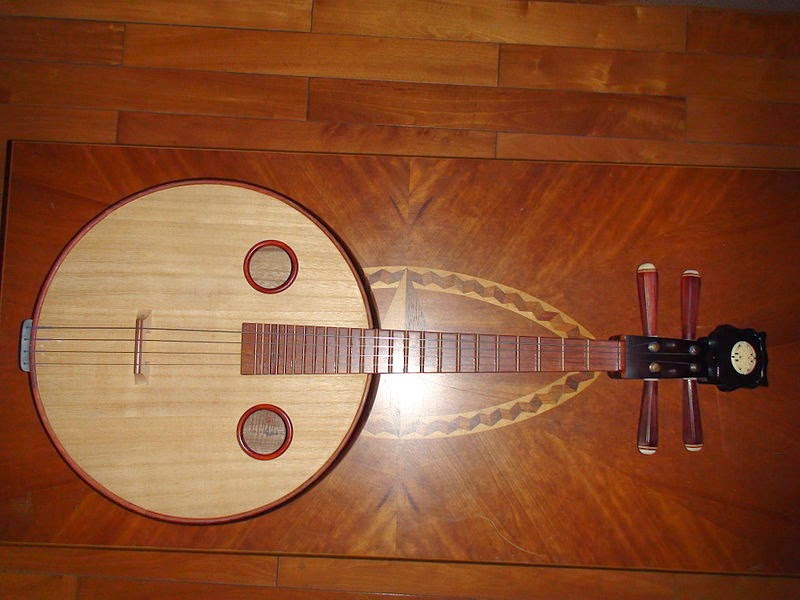Part 1
A middle-aged man, who I took to be the head musician and probably the teacher, came on stage and prefaced each song with what appeared to be rather witty dialogue. I cannot confirm that, as my Chinese is still underdeveloped, but the audience (unlike the queen) seemed amused.I believe he had a pipa (琵琶) with him, though it may have been a liuqin (柳琴).
 A pipa
A pipa A liuqin
A liuqinThe music was charming and had a quality to it that's hard to pin down. I'm sure my friend with his musical degree could provide the technical words I lack. Needless to say it was a treat.
After a few songs (and jokes) he left, only to return accompanied by a string of thirteen lovely young ladies, each sporting their own Liuqin. They were all dressed in a mock qipao (旗袍) or cheongsam style. Traditionally the qipao is a one-piece dress with cap sleeves and ending in a cut not dissimilar to a pencil skirt. If I recall correctly, only two of the ladies actually wore a proper qipao. Two others wore evening dresses and the rest had a kind of qipao blouse worn with a separate skirt.


Sitting in a single, long, curved line they played flawlessly together. They played in perfect harmony even when altering the tempo of the music and they played with incredible speed, their hands seeming to dance across the strings becoming blurs.
After a quick rearranging by the backstage team (and I must commend the backstage team on their speed and efficiency) the head musician returned with an entourage of older musicians. They assembled themselves around a table with various instruments laid out. They had liuqins, pipas, sanxians (三弦) and huqins (胡琴). This stage of the concert also saw the introduction of a few woodwind instruments. There was the sheng (笙) as well as the dizi (笛子) which is a kind of bamboo flute.
 A dizi
A dizi A huqin
A huqin A sanxian
A sanxian  A sheng
A shengDuring this time one thing became quite noticeable which put a dampener on the event, but not enough to make me stop enjoying it. Chinese instruments were designed and created to be played individually or in small groups, usually to a small reception. Putting this number of instruments together, whilst trying to amplify their sound to the whole chamber, means that some instruments were almost inaudible.
The Sheng I don't believe I heard above the sound of the strings.
Part 2
We returned after the interval to a complete rearrangement of the stage. A mini orchestra assembled on stage. The orchestra is a relatively new concept to Chinese history. As such, not all of their instruments are designed to work well in groups. Certain instruments have been borrowed from the western orchestra, like cellos and double-basses.There was even more excitement when a host of operatic singers lined the back wall, ladies dressed in deep, rich pink and men in tuxedos. This is when it became undeniably clear that we were listening to contemporary music rather than traditional.
The singers didn't sing a song. Rather, they had associated pitch to various words and as they sang these words (or perhaps sounds is a better way of describing them) they would alter their pitch. At first it they were simply changing to pitch to the sound "la".
Later they changed to short sentences in Chinese, each word holding its own pitch.
The strangest part of this was the karaoke section. I don't know what else to call it. No other word seems to fit. Whilst in the middle of a tune two of the elder musicians stood up with mics and began singing a duet. Later in the same song the were replaced by two others. The audience seemed impressed by one of them, as though he was singing tongue-twisters or something in a similar vein. It was interesting, but most confusing. I'm still unsure what I witnessed.
Then, because you can never have enough, the thirteen young ladies from before were brought out and added to the orchestra for the finalé. Though odd, it was a wonderful evening out.
No comments:
Post a Comment